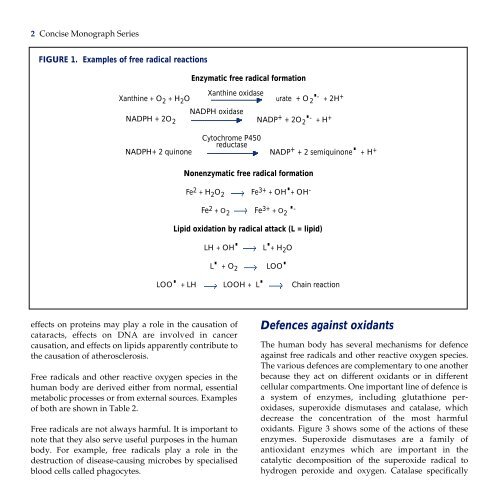Oxidants, Antioxidants and Disease Prevention - Aara-Super food
Oxidants, Antioxidants and Disease Prevention - Aara-Super food
Oxidants, Antioxidants and Disease Prevention - Aara-Super food
You also want an ePaper? Increase the reach of your titles
YUMPU automatically turns print PDFs into web optimized ePapers that Google loves.
2 Concise Monograph Series<br />
FIGURE 1. Examples of free radical reactions<br />
Enzymatic free radical formation<br />
Xanthine oxidase<br />
urate + O 2<br />
.<br />
Xanthine + O - + 2H +<br />
2 + H 2 O<br />
NADPH oxidase<br />
NADPH + 2O NADP + + 2O 2<br />
. - + H +<br />
2<br />
NADPH+ 2 quinone<br />
Cytochrome P450<br />
reductase<br />
NADP + + 2 semiquinone . + H +<br />
Nonenzymatic free radical formation<br />
Fe 2 + H 2 O 2 . Fe 3+ + OH + OH -<br />
Fe 2 + O 2 Fe 3+ + O 2<br />
. -<br />
Lipid oxidation by radical attack (L = lipid)<br />
. . LH + OH L + H 2 O<br />
L . + O 2 LOO .<br />
LOO . + LH LOOH + L . Chain reaction<br />
effects on proteins may play a role in the causation of<br />
cataracts, effects on DNA a re involved in cancer<br />
causation, <strong>and</strong> effects on lipids apparently contribute to<br />
the causation of atherosclerosis.<br />
Free radicals <strong>and</strong> other reactive oxygen species in the<br />
human body are derived either from normal, essential<br />
metabolic processes or from external sources. Examples<br />
of both are shown in Table 2.<br />
Free radicals are not always harmful. It is important to<br />
note that they also serve useful purposes in the human<br />
body. For example, free radicals play a role in the<br />
destruction of disease-causing microbes by specialised<br />
blood cells called phagocytes.<br />
Defences against oxidants<br />
The human body has several mechanisms for defence<br />
against free radicals <strong>and</strong> other reactive oxygen species.<br />
The various defences are complementary to one another<br />
because they act on different oxidants or in different<br />
cellular compartments. One important line of defence is<br />
a system of enzymes, including glutathione peroxidases,<br />
superoxide dismutases <strong>and</strong> catalase, which<br />
d e c rease the concentration of the most harmful<br />
oxidants. Figure 3 shows some of the actions of these<br />
enzymes. <strong>Super</strong>oxide dismutases are a family of<br />
antioxidant enzymes which are important in the<br />
catalytic decomposition of the superoxide radical to<br />
hydrogen peroxide <strong>and</strong> oxygen. Catalase specifically

















